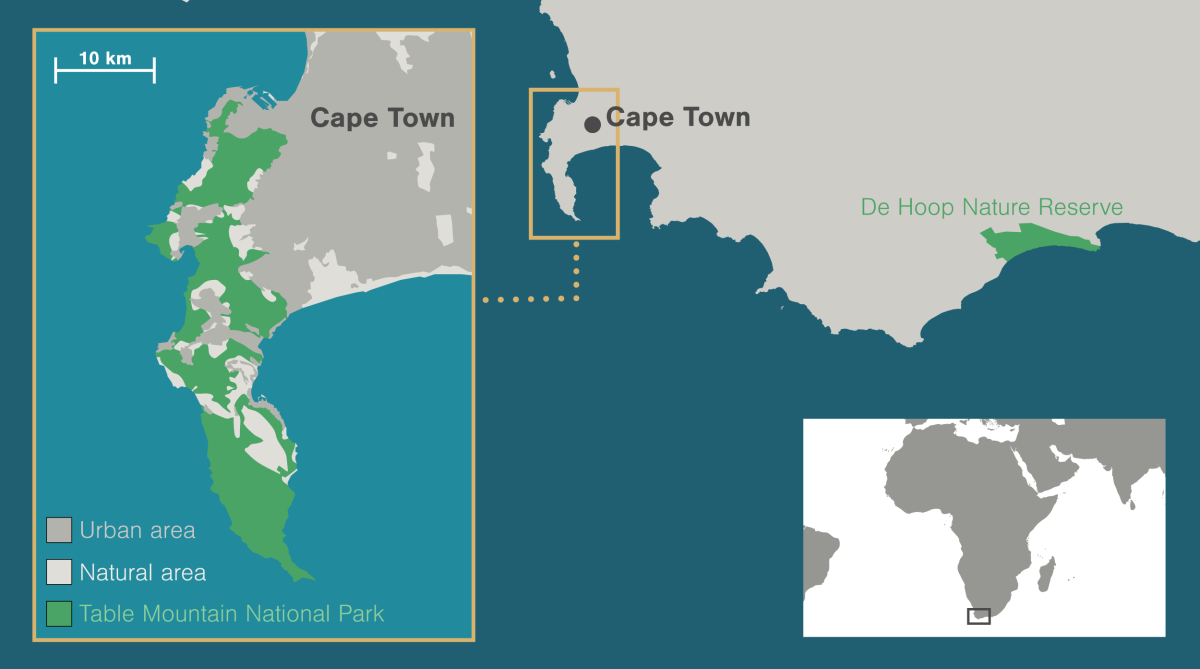This South African Wildcat Has a Taste for Endangered Seabirds
Squeezed between the ocean and Cape Town’s urban sprawl, coastal caracals are the first felines to regularly dine on marine prey.
Article body copy
House cats may have a reputation for enthusiastically chowing down on fish, but in the wild, few felines consume prey from the ocean. In South Africa, though, scientists have recently discovered a small group of caracals—lithe russet-colored wildcats with short tails and long tufted ears—regularly eating seafood. Only, instead of fish, these cats are hunting seabirds.
This unique diet qualifies these coastal caracals as a new ecotype, says Gabriella Leighton, a conservation biologist at South Africa’s University of Cape Town. The wildcats live across parts of Asia—including the Arabian Peninsula—and Africa, where they eat a varied diet of birds, rodents, lizards, snakes, and antelope. But in the recent study, Leighton and her colleagues find that coastal caracals living on the 52-kilometer-long Cape Peninsula, south of Cape Town, often hunt endangered Cape cormorants and African penguins, among other species. Together, these seabirds make up roughly one-third of the caracals’ diet.
“This seems to be the first example that we’ve seen, in the literature at least, of a cat that’s regularly feeding on marine prey,” says Leighton. Other cases—such as pumas noshing on green turtles in Costa Rica or jaguars scavenging dolphin carcasses in Honduras—are either opportunistic or seasonal, she says.
On the Cape Peninsula, caracals are squeezed between the sea and Cape Town’s urban sprawl. The city’s neighborhoods and roads—where caracals are often killed by drivers—act like a wall, making it difficult for the cats to move off the peninsula to find more traditional fare.
By tracking the movements of GPS-collared cats and analyzing caracal fur, scat, and prey, Leighton and her colleagues noticed a marked difference in what the felines eat in different areas. Caracals on the outskirts of Cape Town, at the northern end of the peninsula, prey on Egyptian geese, helmeted guineafowl, and vlei rats—animals that flourish in human-made habitats. (In a previous study, Leighton concludes that Cape cormorants make up less than one percent of what these cats eat.)
But for caracals living to the south, in and around Table Mountain National Park, cormorants—and to a lesser extent penguins, gulls, gannets, and terns—constitute more than 27 percent of their diet. Leighton and her team dubbed some cats “seabird-hunting specialists.” For four of these individuals, seabirds made up nearly half of their food.
The researchers hypothesize that the southern caracals turned to seabirds because the rugged, shrubby landscape of the park doesn’t sustain enough rodents or terrestrial birds.
But the caracals’ taste for endangered seabirds is causing problems, in part because the cats sometimes kill more birds than they can eat.
In 2016, Cape Town authorities relocated a female caracal, nicknamed Disa, away from Boulders Beach, the peninsula’s famous penguin colony, where she had been hunting the birds. But her son, Houdini, quickly moved in to replace her—within several months, the two cats killed about 130 penguins out of the colony’s roughly 2,000 birds.
Compared with cormorants, penguins are rarely on caracals’ menu, but conservationists worry that similar killing sprees would make things even worse for the struggling species. The number of African penguins has plummeted from around one million breeding pairs in 1920 to just 9,900 pairs today—partly because people have overfished anchovy and sardines, the penguins’ primary prey. According to the Cape Town–based nonprofit Southern African Foundation for the Conservation of Coastal Birds (SANCCOB), the beloved birds could be extinct in the wild by 2035.
Fortunately, caracal predation is unlikely to threaten the persistence of Cape cormorants, even though these birds are also in decline due to food shortages and past outbreaks of avian cholera at some of their South African breeding colonies. Christina Hagen, a penguin conservation biologist at BirdLife South Africa, points out that the cormorants can fly away and even change where they roost and breed to evade predators.
African penguins, on the other hand, tend to stick to established colonies, Hagen says. There, the flightless birds are sitting ducks, so to speak, for the cats, which can also disrupt the penguins’ breeding behavior. In 2008, for example, penguins abandoned a new colony at De Hoop Nature Reserve, about 200 kilometers east of the Cape Peninsula, after a caracal killed several birds there.
To protect the Boulders Beach penguins, Cape Town authorities also erected a temporary fence in 2020, which seems to have reduced the number of penguins killed by caracals at that colony, says SANCCOB research manager Katrin Ludynia.
What the fence will mean for these adaptable cats, though, is uncertain. This ecotype is very rare—and perhaps worthy of preserving. “This is a native predator that’s feeding on prey that’s available to it,” says Leighton. “It’s not something that we necessarily want to stop.”
“Balancing the needs of different species is a challenge, especially when some or all of the species involved are endangered or threatened with extinction,” adds Hagen. “But [it’s] definitely something worth striving toward.”


